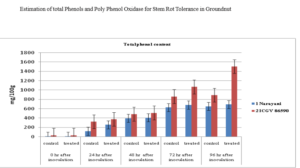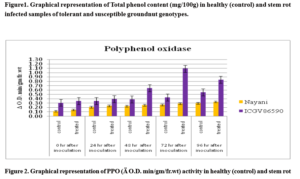ESTIMATION OF TOTAL PHENOLS AND POLY PHENOL OXIDASE FOR STEM ROT TOLERANCE IN GROUNDNUT.
0 Views
S. RAJASEKHAR, Y. AMARAVATHI, R.P. VASANTHI AND N.P. ESWARA REDDY
Department of Plant Molecular Biology and Biotechnology, S.V. Agricultural College, ANGRAU,Tirupati-517502, Andhra Pradesh.
ABSTRACT
One groundnut stem rot tolerant and susceptible genotypes were evaluated for their biochemical constituents after inoculation with Scelortium rolfsii at 24 hrs interval up to 4 days. The total phenols content increased significantly in both the genotypes at all stages; however, higher accumulation of phenols was noticed at 96 hrs after inoculation. Total phenol content in tolerant genotype ICGV 86590 was increased by 1.2 folds at 72 hrs after inoculation and further increased by 1.7 folds at 96 hrs after inoculation in comparison with the susceptible genotype, Narayani. The higher accumulation of phenols at 96 hrs after inoculation might be due to the higher disease intensity which was corresponding to the most vulnerable stage of infection. PPO activity in ICGV 86590 gradually increased up to 72 hrs and slightly reduced at 96 hrs after S. rolfsii inoculation.
KEY WORDS:
Sclerotium rolfsii, groundnut, total phenols and Poly phenol Oxidase (PPO).
INTRODUCTION
Groundnut (Arachis hypogea L.) is popularly known as ‘king of oil seeds’. It is one of the most important food and cash crop of India. While being a valuable source of all the nutrients, it is a low-priced commodity. Groundnut haulms and leaves serves as a rich source of cattle feed and raw material for preparation of silage.
Among the various fungal diseases, stem rot a soil born disease caused by Sclerotium rolfsii, is one of the major constraints in groundnut production as it severely affect the yield and quality of the produce (Mehan and McDonald, 1990). The persistence of S. rolfsii in the soil and its wide range of hosts often limits the effectiveness management of stem rot in groundnut (Buensanteai et al., 2012). During infection, the pathogen secretes cell wall degrading enzymes and subsequent colonization in host tissues by suppressing the defense responses of the host. Better understanding of the plant pathogen interaction, role of secondary metabolites such as phenols, PPO and genetic mechanisms of resistance are highly
essential for both conventional and molecular breeding of groundnut for stem rot (Casassola et al., 2013).
MATERIALS AND METHODS
The experimental material consisted of one stem rot resistant genotype ICGV 86590 and one susceptible genotype Narayani inoculated with Scelortium rolfsii at 24 hrs interval up to 4 days and test genotypes without S. rolfsii inoculation were used as control.
ESTIMATION OF TOTAL PHENOLS:
Total phenol was estimated as per the protocol of Malik and Singh (1980). One gram of fresh sample (stem portion near collar region) was grinded to fine powder with liquid nitrogen, mixed with 10ml of 80 per cent ethanol and centrifuged at 10,000 rpm for 20 min. The supernatant was collected and dried at room temperature. The residue was dissolved in 10 ml of distilled water. For extraction of total phenols, the sample was prepared by taking 0.4 ml of the extract and volume was made up to 3ml with distilled water. To this mixture, 0.5 ml of folin-ciocalteau reagent was added and incubated for 3 minutes. Following incubation, 2ml of 20% Na2Co3 was added and samples were placed in boiling water for one minute. Samples were
cooled and totalphenols content was estimated by the absorbance measured at 650nm using visible spectrophotometer (UV 2450). A blank was used as standard check for comparison.
ESTIMATION OF POLYPHENOL OXIDASE (PPO) (EC 1.14.18.1) ACTIVITY:
Polyphenol oxidase was measured by following method of Esterbaner et al. (1977) with slight modifications. 0.1 gram of fresh sample was grinded to fine powder with liquid nitrogen and mixed with 5 ml of 100mM sodium phosphate buffer (pH 6.5) (appendix). The homogenate was centrifuged at 10,000 rpm at 40C for 15 min and the supernatant was used as enzyme extract. Blank was also prepared without the sample. 100 ìl of supernatant was mixed with 2.9 ml of catechol (10 mM catechol in 10 mM phosphate buffer, pH 6.5). The changes in the colour due to the oxidized catechol were measured at 265 nm by visible spectrophotometer (UV 2450) for one minute at an interval of 15 second. The polyphenol oxidase activity was calculated by change in OD value/min/gram of fresh weight.
RESULTS AND DISCUSSION
TOTAL PHENOLS:
S. rolfsii infection increased the total phenol content significantly in both the genotypes at all stages; however, the higher accumulation of phenols was noticed 96 hrs after inoculation in comparison with their respective controls.
Initially, both tolerant and susceptible genotypes showed similar kind of accumulation of phenols however the accumulation was relatively higher in ICGV 86950 from 72 (1068.10 U) to 96 (1506.38 U) hrs after inoculation when compared to susceptible genotype Narayani (681.3 to 691.54 U).
Total phenol content increased by 1.2 folds at 72 hrs after inoculation and further increased by 1.7 folds at 96 hrs after inoculation in comparison with respective controls (Figure 1). The higher accumulation at 96 hrs after inoculation might be due to the higher disease intensity which was corresponding to the most vulnerable
stage of infection
The present results were in accordance with the previous reports in hypocotyls of groundnut challenged with S. rolfsii at 10 days after inoculation in (Reddy and Sireesha, 2014).
POLYPHENOL OXIDASE (PPO) (EC 1.14.18.1)
ACTIVITY:
PPO is a nuclear encoded enzyme that catalyzes the oxygen-dependent oxidation of phenols to quinones. PPO increased significantly up to 72 hrs after inoculation in ICGV 86590 (Figure 2).
PPO activity in ICGV86590 at 24hrs was 0.40 U and gradually increased up to 72 hrs (1.091 U) and slightly reduced at 96 hrs (0.84) after S. rolfsii inoculation. The PPO activity in susceptible genotype (Narayani), also exhibited similar trend but it was three-fold less when compared to the resistant genotype.
Results of present studies were in agreement with the findings of Doley et al., (2014) in groundnut challenged with stem rot pathogen. Increased PPO activity against wilt were also reported in chickpea (Rathod and Yakhariya, 2016).


SUMMARY AND CONCLUSION
When total phenol content was tested in the pathogen inoculated genotype ICGV 86590, maximum accumulation was observed between 72 to 96 hrs after inoculation. The elevated levels of total phenol plays an important role in the resistance mechanism of the tolerant groundnut genotype against infection with S. rolfsii. When PPO activity was tested, the activity increased significantly up to 72 hrs after inoculation in ICGV 86590 and reduced slightly at 96 hrs. PPO activity was more in tolerant genotype than the susceptible genotype.
LITERATURE CITED
- Buensanteai, N., Thumanu, K., Kooboran, K., Athinuwat, D and Sutruedee P. 2012. Biochemical adaptation of phytopathogenic fungi Sclerotium rolfsii in response to temperature stress. African Journal of Biotechnology. 11(84): 15082-15090.
- Casassola, A., Brammer, P.S., Chaves, S. M., Martinelli, A.J., Grando, F.M. and Denardin, D.N. 2013. Gene expression: A review on methods for the study of Defense-related gene differential expression in plants. American Journal of Plant Sciences. 4:64-73.
- Doley K., Dudhane, M and Borde, M. 2017. Biocontrol of Sclerotium rolfsii in Groundnut by Using Microbial Inoculants. Notulae Science Biologicae. 9(1):124-130.
- Esterbaner, H., Schwarzl, E and Hayn, M. 1977. A rapid assay for catechol oxidase and laccase using 2 nitro-5-thio benzoic acid. Analytical Biochemistry. 77:486-494.
- Mehan, V.K and McDonald, D. 1990. Some Important diseases of groundnut sources of resistance and their utilization in crop improvement. Paper presented at: The In Country Training Course on Legumes Production, 9-17 July, 1990, Sri Lanka.
- Malik, C.P and Singh, M.B. 1980. Plant Enzymology and Histoenzymology. Kalyani Publishers, New Delhi.
- Rathod, P.J and Vakhariya, D.N. 2016. Role of PAL and PPO Enzyme Activity in Host Pathogen interaction of Chickpea (Cicer arietinum L) Root Tissue Infected with Fusarium wilt. International Journal of Environment Agriculture and Biotechnology. 1(4): 1912 1919.
- Reddy, M.N and Sireesha, C.H. 2014. Role of oxidative enzymes and biochemical constituents in imparting resistance to groundnut (Arachis hypogaea L.) against stem rot disease caused by Sclerotium rolfsii. Bioresearch Bulletin. 36-41.
- Bio-Formulations for Plant Growth-Promoting Streptomyces SP.
- Brand Preference of Farmers for Maize Seed
- Issues That Consumer Experience Towards Online Food Delivery (Ofd) Services in Tirupati City
- Influence of High Density Planting on Yield Parameters of Super Early and Mid Early Varieties of Redgram (Cajanus Cajan (L.) Millsp.)
- Influence of Iron, Zinc and Supplemental N P K on Yield and Yield Attributes of Dry Direct Sown Rice
- Effect of Soil and Foliar Application of Nutrients on the Performance of Bold Seeded Groundnut (Arachis Hypogaea L.)

